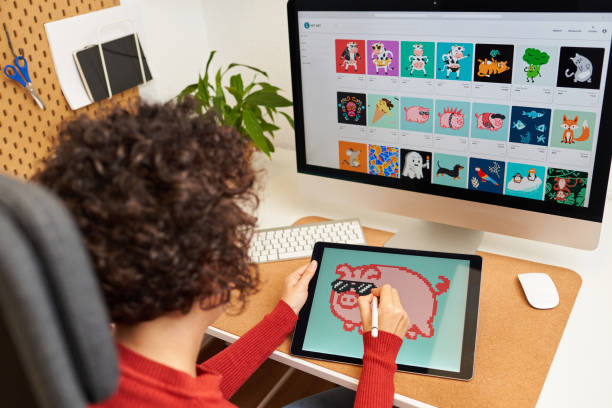Understanding the Metaverse
The Metaverse, a term coined from science fiction, has transcended its literary origins to become a burgeoning digital frontier. It represents an expansive network of 3D virtual worlds focused on social connection, made possible through the convergence of virtual reality (VR), augmented reality (AR), and blockchain technologies. As the digital and physical realms increasingly intertwine, the Metaverse presents a novel landscape for digital marketing strategies. This blog explores how businesses can navigate this new world, transforming virtual experiences into real-world value.
At its core, the Metaverse is a collective virtual shared space, created by the convergence of virtually enhanced physical and digital reality. It encompasses environments where users, represented as avatars, can interact with each other and digital objects in real-time. Beyond entertainment, the Metaverse serves as a fertile ground for digital marketing, offering immersive experiences that traditional media cannot match.

Digital Marketing in the Metaverse: Opportunities and Strategies
Immersive Brand Experiences
The Metaverse enables brands to create immersive experiences that go beyond conventional advertising. For instance, fashion brands can launch virtual stores where users can try on and purchase clothing. Some brands even offer clothes to purchase for user’s avatars. This not only provides a unique brand interaction but also taps into the virtual economy of the Metaverse.
Enhanced Customer Engagement
Virtual worlds offer new avenues for customer engagement through interactive events and experiences. Brands can host virtual concerts, product launches, or workshops, attracting attendees from across the globe. This level of interaction fosters a deeper connection between the brand and its audience, enhancing customer loyalty and engagement.
Leveraging Virtual Real Estate
Owning or leasing virtual real estate in popular areas of the Metaverse can be a strategic move for brands. It allows for the establishment of permanent virtual stores, billboards, or experiential spaces where users can engage with the brand in a more meaningful way. The location and design of these virtual spaces can significantly impact brand visibility and user traffic.

NFTs and Digital Ownership
Non-fungible tokens (NFTs) offer a unique mechanism for brands to engage with their audience in the Metaverse. By creating branded NFTs—ranging from digital merchandise to exclusive access tokens—brands can offer a new level of digital ownership and exclusivity, appealing to both collectors and fans.

Challenges and Considerations
While the opportunities are vast, navigating the Metaverse comes with its own set of challenges. Issues such as digital security, user privacy, and the digital divide need careful consideration. Brands must also ensure that their virtual endeavors align with their overall marketing strategy and brand values, avoiding gimmicks in favor of genuinely valuable and engaging experiences.
“Entering the metaverse is like exploring a new continent. The opportunities for engagement and brand expansion are immense, but so are the challenges of creating authentic and inclusive experiences. As we navigate this digital frontier, it’s essential for marketers to remember that technology is at its best when it enhances human connections, not replaces them.”
Cathy Hackl, Chief Metaverse Office
Organisations on the Frontier
- Balenciaga: The luxury fashion brand partnered with Epic Games’ Fortnite to create a virtual clothing line for the game’s avatars, blending high fashion with popular culture and gaming. This collaboration not only served as a digital marketing campaign but also as a bridge between luxury fashion and gaming communities.
- Nike: Nike has been pioneering in the metaverse space with its virtual world called “Nikeland” on Roblox. Nikeland allows users to dress their avatars in Nike gear, participate in sports-related games, and even create their own minigames. This virtual environment not only engages users but also serves as a digital marketing platform for showcasing Nike products.
- BMW: BMW introduced its vision of the future in the metaverse with the virtual unveiling of concept cars in virtual worlds. This approach allowed BMW to create an immersive brand experience that transcends physical boundaries, reaching a global audience in innovative ways.
- Coca-Cola: Coca-Cola has tapped into the metaverse through NFT (Non-Fungible Token) auctions and virtual experiences. For example, they launched a virtual Coke can design as an NFT and hosted a virtual party in Decentraland, a decentralized virtual reality platform. These efforts showcase Coca-Cola’s brand in a new, interactive format, appealing to digital collectors and virtual world enthusiasts.
Final thoughts
The Metaverse represents a new frontier for digital marketing, offering unparalleled opportunities for brand innovation, customer engagement, and immersive experiences. As we venture further into this virtual realm, the key to success lies in leveraging these opportunities creatively and strategically, ensuring that digital endeavours translate into tangible brand value. The journey from virtual worlds to market strategies in the Metaverse is just beginning, and the possibilities are as limitless as the imagination.
This exploration offers a glimpse into the potential of digital marketing in the Metaverse, highlighting the need for brands to adapt and innovate within this evolving landscape. As the Metaverse continues to grow, so too will the opportunities for brands to connect with their audience in meaningful and transformative ways.

Leave a Reply
You must be logged in to post a comment.